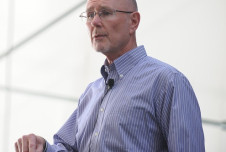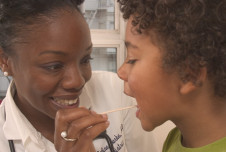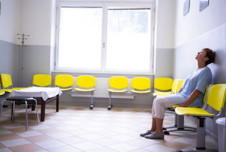Some months ago, I was working a busy evening shift in our emergency room (ER). I had just stabilized a very sick patient and approached a physician colleague to refer the patient to him for admission to the ward. The dialogue that ensued was a perfect example of conflicted agendas: I needed to provide comprehensive early care to the patient while still managing the ER’s overall workload and flow; he was struggling to manage his own workload and was hoping to delay his involvement and contribution.

Ultimately, I demanded his review and admission of the patient and we both left the conversation annoyed, frustrated, and unsettled. As I gathered myself, I was incensed at what I perceived to be his lack of care, interest, and professionalism. I worked effectively for the rest of my shift, but I found myself occasionally pre-occupied and distracted by the dissatisfaction resulting from our interaction.
Working in an ER poses constant challenges. There are the predictable ones such as dealing with sick people and their families, making clinical decisions and plans for patients, and contending with a busy workload in a crowded space with finite resources—trying to achieve the greatest good for the greatest number of people.
There are also challenges that may be less obvious to those outside this work environment: the difficulty of self-care during a shift (meeting one’s basic needs like taking a meal break or even going to the restroom); the physiological fatigue of standing for long periods and walking kilometers in one work day; and the physical risk of looking after patients who are behaviorally unpredictable for various reasons. The psychological and cognitive load for ER staff can threaten to become overwhelming.
Even if you don’t work in an emergency room, your work environment may also feel busy and even chaotic at times. Besides affecting productivity and mental health, this can make it difficult to maintain positive relationships with coworkers, clients, and customers. Like more and more organizations these days, we decided to create a wellness program to help provide some relief—and the lessons we learned are relevant even if your office isn’t a hospital.
Three core practices
One year ago, a group of us became interested in mindfulness practice and whether it would be feasible and valuable in the midst of our busy ER. We learned about the philosophy and practice of mindfulness, attended a short training course, and explored the prospect of embedding some low-intensity activity into the midst of our work environment.
Our structured practice, called oneED (ED stands for “emergency department”), invites and encourages our ER team members to participate in three simple practices.
- A four-minute pause at morning clinical handover, the time in the morning when the night-shift team transfers care of patients to the early-shift team. Up to 45 of us gather in one room to listen to a senior doctor, who might play a video about mindfulness or share a reflective thought about stress management or attention. Then, the doctor guides us through a 90-second sitting meditation. One senior colleague used the four-minute pause one morning to share her approach of “always looking for rainbows” at intervals during her shift: a laughing child, a relieved parent, a reassuring investigation result, a helpful colleague. She encouraged the team to see rainbows in each other, so that together we could work to serve the patient.
- Moments of mindfulness throughout the workday, when staff become overwhelmed or need to enhance their focus. We post mindfulness-themed flyers around the ER, which feature simple thoughts and reflections as reminders of this.
- A weekly drop-in 30-minute session whereby those who are interested and available can gather for journaling, partner exercises, and sharing of experiences.
Besides these formal components of the program, I’ve observed many ways that mindfulness is becoming part of the culture of our ER.
For example, a very senior doctor incorporates notions of mindfulness and attention into his teaching of other doctors. He was recently facilitating a session where doctors were simulating care of a critically unwell infant. The senior doctor observed that the doctor in charge of manually ventilating the infant mannequin was also simultaneously giving directions to the remainder of the team, distracting them from a crucial aspect of caring for a sick baby. He pointed out that the doctor should mindfully focus attention solely on ensuring that air goes in and out of the lungs, and delegate all other tasks.
Another day, the ER was challenged when many staff were on sick leave, many patients were coming in, and the hospital wards were too full for us to transfer many patients out. During a team huddle, the director turned to me to ask if I had anything to add. I said I didn’t, but light-heartedly added, “Unless you all want to do a short meditation before you start.” The nurses responded in unison, “Yes!” (“It sounds like it would be very useful today,” the nursing leader added.) And so I led a 90-second guided sitting meditation before we all dispersed.
Nine tips for implementing a wellness program in a busy workplace
One year later, our embedded mindfulness practice program, while still in its infancy, is going strong. Here is what we have learned so far about implementing a mindfulness-based wellness program in a busy workplace.
1. Think small.

When we initiated our program, while there was interest at an organization-wide level, there wasn’t the capacity to support implementation so broadly. So we focused back into our ER, where we would be visible and present to engage staff and sustain the program.
When starting off, it helps to align your sphere of influence with your sphere of concern, and focus on your local environment.
2. Leverage the science.
The major drawcard for selecting mindfulness as the basis for our oneED wellness program was the compelling scientific evidence behind it.
Studies have shown that mindfulness curbs the stress response. With training, anatomical and physiological changes occur in the brain and the nervous system that modulate this response.
Studies also show that these changes translate into modified behaviors, including greater attention control and emotional regulation.
3. Be inclusive.
Emergency healthcare—like most healthcare—is team-based care. There is never a solo champion; there is never a hero in the Resuscitation Room. Every team member plays an integral role: the doctor who intubates the patient, the nurse who draws up the drugs, the administrative officer who links the patient details to the medical record, the social worker who supports the family, the orderly who transports the patient to the CT scanner, the cleaner who wipes down the room afterwards.
It was imperative that our program include this whole breadth and depth of staff. Their access to the program varies, depending on whether their role is dedicated to the ER or dispersed across services. However, everyone is invited to participate.
One of my colleagues likes to say, “It doesn’t matter where you work or what you do. What matters is who you work with.” He encourages us to create an environment so supportive and enjoyable that we can’t help but feel happy to be at work together.
4. Right here. Right now.
The last thing a busy staff member needs is one more thing on their to-do list, so bring mindfulness practice directly to the staff. The oneED program does not require staff to be removed from their immediate work environment in order to engage. Our structured activity was designed to encourage staff to conduct short, simple practices in the midst of their daily work schedule.
For example, before the arrival of a critically unwell and unstable patient, one colleague typically accompanies her hand-washing with a conscious square breath: inhale for 4 seconds, hold for 4 seconds, exhale for 4 seconds, hold for 4 seconds. She makes a concerted effort to only breathe and not think for those 16 seconds. She is convinced that this helps her to clear a space in her mind, so that she can then focus on the case and manage her team effectively.
Another suggested strategy is to make logging into your computer program the trigger to take two breaths. Instead of succumbing to frustration and annoyance because of inevitably slow technology, this provides an opportunity for a pause and recharge.
5. One size seldom fits all.
As predicted, some staff were skeptical about mindfulness practice. Although this number was relatively small, we approached the issue with respect and deliberation.
Firstly, we ensured that we made it clear that participation in structured practice was completely optional (although we encouraged staff to at least try it out). Secondly, we broadened our focus back out to wellness, with mindfulness forming one component of this. Other staff members have initiated a cycling group, a social group, and a green-thumbs group, for example. Remember that a given practice will work for some but not for others.
6. It always comes from the top.
Leadership is vital for success, and leaders will determine the approach that the program takes. Our directors’ endorsement and enablement gave us the credibility we needed to initiate, implement, and sustain the program.
For workplaces that may struggle to garner this engagement, we recommend presenting a business case that outlines the need for, and value of, a program like this.
Note also that the leaders within a team may not necessarily be those in formal managerial roles. It is important to seek out and engage these individuals so that they can enhance your efforts within their spheres of influence.
7. Create a champion team.
Our program has been coordinated by a small group of staff out of interest, passion, and goodwill. As such, the program has been very low-cost to date.
However, this carries the risk that the program is dependent on a small number of individuals. It would be better to dedicate resources to the project and create a robustly reliable coordinating team so that the program doesn’t lapse when certain employees are out of the office or leave the organization.
8. Share the love.
Spread the word far and wide. Over time, the oneED program has attracted interest from other departments within our hospital, other health services, and state-wide networks. Our hospital media helped promote the program, which garnered encouraging support from our local community.
9. Get a little help from your friends.
Collaborate widely and generously. Enhance your credibility by connecting with those within the profession who are highly regarded—the thought leaders.
When Dr. Scott Weingart used his plenary session at a major conference to share the value of his meditative practice, many ER workers became interested in the idea—and we set up a conversation with Dr. Weingart about his experience.
Our friends at ALiEM, an education and community organization for the field of emergency medicine, initiated a Wellness Think Tank some months ago, and we have worked together on a number of shared projects.
Within our region, we have banded together with other like-minded emergency physicians and formed a group called WRaP (Wellness, Resilience, and Performance), creating wellness and performance training modules for trainees and physicians alike.
Overall, the key lesson is that the journey to wellness, including the implementation of a workplace-based wellness program, is a marathon and not a sprint. Sustainability and progress require perseverance, patience, and tenacity. Ironically, it is the very practice of mindfulness that helps maintain energy and momentum for the program coordinators.
Creating some space
A core concept of mindfulness is embodied by a famous quote used to describe the work of psychiatrist and Holocaust survivor Victor Frankl: “Between stimulus and response there lies a space. In that space is our power to choose our response.”
This is particularly apt in the ER where, at any given time, we are barraged with inputs, stimuli, and interruptions. Recognizing this space allows us to deliberate before offering an otherwise reflexive response. This, in turn, enhances team dynamics by promoting respectful communication, collaboration, and the ability to recognize shared goals.
That evening when I experienced the conflict with my colleague, I wondered about how I might respond. Should I make a complaint to his boss? Should I confront him myself? I chose the latter course, and initially planned to take him aside and ask him to explain his lack of professionalism. Luckily, I realized that it would be far more self-aware and non-judgmental to start with the statement, “I regret the interaction we had earlier.”
Towards the end of my shift, I sought him out and we engaged in dialogue once again. This time, he apologized for his approach and disclosed that he struggles with anxiety, but that he realized he must learn to manage it. I responded by assuring him that he was not alone and that he demonstrated great insight by recognizing this. We have maintained supportive contact since then.
That evening, a shift that could have ended with dissatisfaction, frustration, and lack of fulfillment instead ended with a deeply gratifying interaction—simply by being mindful, recognizing the space between trigger and response, and then choosing a response which resulted in a profound connection. These are the kinds of benefits you can experience from promoting mindfulness at work.








Comments